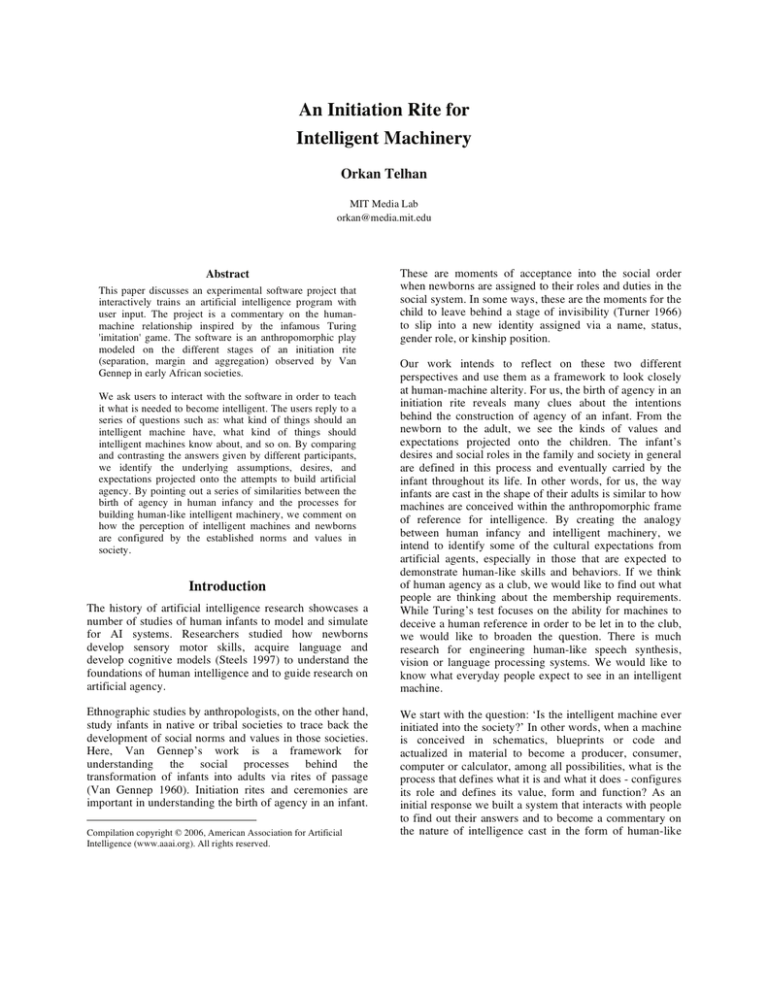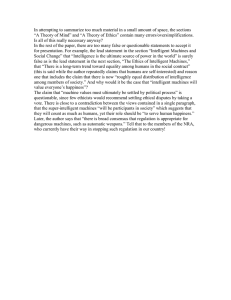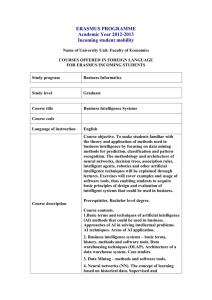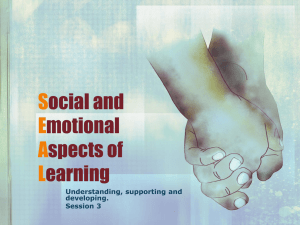
An Initiation Rite for
Intelligent Machinery
Orkan Telhan
MIT Media Lab
orkan@media.mit.edu
Abstract
This paper discusses an experimental software project that
interactively trains an artificial intelligence program with
user input. The project is a commentary on the humanmachine relationship inspired by the infamous Turing
'imitation' game. The software is an anthropomorphic play
modeled on the different stages of an initiation rite
(separation, margin and aggregation) observed by Van
Gennep in early African societies.
We ask users to interact with the software in order to teach
it what is needed to become intelligent. The users reply to a
series of questions such as: what kind of things should an
intelligent machine have, what kind of things should
intelligent machines know about, and so on. By comparing
and contrasting the answers given by different participants,
we identify the underlying assumptions, desires, and
expectations projected onto the attempts to build artificial
agency. By pointing out a series of similarities between the
birth of agency in human infancy and the processes for
building human-like intelligent machinery, we comment on
how the perception of intelligent machines and newborns
are configured by the established norms and values in
society.
Introduction
The history of artificial intelligence research showcases a
number of studies of human infants to model and simulate
for AI systems. Researchers studied how newborns
develop sensory motor skills, acquire language and
develop cognitive models (Steels 1997) to understand the
foundations of human intelligence and to guide research on
artificial agency.
Ethnographic studies by anthropologists, on the other hand,
study infants in native or tribal societies to trace back the
development of social norms and values in those societies.
Here, Van Gennep’s work is a framework for
understanding the social processes behind the
transformation of infants into adults via rites of passage
(Van Gennep 1960). Initiation rites and ceremonies are
important in understanding the birth of agency in an infant.
Compilation copyright © 2006, American Association for Artificial
Intelligence (www.aaai.org). All rights reserved.
These are moments of acceptance into the social order
when newborns are assigned to their roles and duties in the
social system. In some ways, these are the moments for the
child to leave behind a stage of invisibility (Turner 1966)
to slip into a new identity assigned via a name, status,
gender role, or kinship position.
Our work intends to reflect on these two different
perspectives and use them as a framework to look closely
at human-machine alterity. For us, the birth of agency in an
initiation rite reveals many clues about the intentions
behind the construction of agency of an infant. From the
newborn to the adult, we see the kinds of values and
expectations projected onto the children. The infant’s
desires and social roles in the family and society in general
are defined in this process and eventually carried by the
infant throughout its life. In other words, for us, the way
infants are cast in the shape of their adults is similar to how
machines are conceived within the anthropomorphic frame
of reference for intelligence. By creating the analogy
between human infancy and intelligent machinery, we
intend to identify some of the cultural expectations from
artificial agents, especially in those that are expected to
demonstrate human-like skills and behaviors. If we think
of human agency as a club, we would like to find out what
people are thinking about the membership requirements.
While Turing’s test focuses on the ability for machines to
deceive a human reference in order to be let in to the club,
we would like to broaden the question. There is much
research for engineering human-like speech synthesis,
vision or language processing systems. We would like to
know what everyday people expect to see in an intelligent
machine.
We start with the question: ‘Is the intelligent machine ever
initiated into the society?’ In other words, when a machine
is conceived in schematics, blueprints or code and
actualized in material to become a producer, consumer,
computer or calculator, among all possibilities, what is the
process that defines what it is and what it does - configures
its role and defines its value, form and function? As an
initial response we built a system that interacts with people
to find out their answers and to become a commentary on
the nature of intelligence cast in the form of human-like
skills and behaviors. We use Turner’s vocabulary to refer
to our software as a ‘neophyte machine’.
The Initiation of the Neophyte
Initiation Rite
Our system is a software application that simultaneously
interacts with multiple people (a minimum of three) via
text input. It is designed as an anthropomorphic play
modeled on Van Gennep’s analysis of initiation rites with
three stages: separation, margin, and aggregation.
Participants interact with the software by answering
questions displayed on a graphical interface.
Separation. The software in its first stage submits itself to
its users and acts only as an input device that would like to
leave behind its previous stage to become an intelligent
machine. It asks the participants their names in an obedient
manner. After learning who the teachers are, separation
begins as the neophyte submits itself to its instructors in
the hope of learning:
- What and who the machine is (to be given its name and
role or function).
- What it should know about the world (to acquire a level
of literacy).
- What it should not know about the world (to get a sense
of moral values).
- What it should be able to do (to be assigned its duties as a
cultural object).
- What it should not do (to get a sense of the amount of
regulation of its abilities of access and control).
- Where intelligent machines belong (to find its position in
the social order).
The users respond each question one by one and proceed to
the next. While every user replies to the questions on
separate terminals, the neophyte collects all of the
information to form its knowledge base. It parses the
information to extract the nouns and verbs. After a basic
evaluation, it checks whether there are any overlaps and
repetitions in the dataset. In almost every session the
answers are quite, diverse depending on the social and
cultural backgrounds of the users. While there may be
some overlaps, we observed more non-matching answers,
mainly because of the open nature of the questions.
Margin. Next, the margin state begins, as the information
needs to be verified. The neophyte looks for solid answers
to make up its mind. It inevitably replies in a confused
way, contesting the user in various ways:
- Hey Sam (the current participant), it looks like Carol
(another participant) thinks that an intelligent machine
should have an “umbrella,” but you didn't say that.
Both Barbara and Sam think that an intelligent machine
should know about “homes”. But Bill doesn't think that is
important. Isn’t this confusing?
Figure 1 Screens from separation and
aggregation stages
These are simple template driven replies phrased in a
couple of ways. The software uses the user names and their
answers to generate sentences. The neophyte then asks the
master to have a seat while the interface changes to another
screen asking for evaluations. Here, the participants are
asked to rate the quality of the different answers to the
same questions. They are asked to give a number from one
to five for each answer. As each participant is presented
with the other two participant’s answers, they rank each
other's answers to show which answers they think are
better. Without being able to rank their own answer, they
order the data for the machine and the machine uses it as
criteria for making judgments about what really is
considered important on its way to become intelligent.
Aggregation. The final stage begins with the machine
presenting its results. After determining who scored better
in the analysis of the intelligence, it now has a better sense
of what intelligence is:
Clearly, you are not intelligent Mike, because you told me
that I need an “umbrella” to be an intelligent machine. But
if it is not going to “rain” today, why should I need to
“carry” one?
The software generates its provocative replies by using the
common sense reasoning application ConceptNet (Liu et
al. 2004). If the user answers the question “what the
machine should have” with a noun such as “umbrella”, we
use it to query ConceptNet for its further associations. By
finding out the association of “umbrella” with “rain” and
“carrying”, the software can generate very basic constructs
with a number of templates that accept nouns and verbs to
fill up the sentences.
As the ranking is done among the replies collected from
current participants, the attributes of intelligence used for
judgment are only valid for that particular session. If the
users choose to perform again in another time, and even if
they give the same answers, they may or may not still be
considered intelligent by the system. As the criteria of
intelligence are based on the evaluations of users ranking
each other, the machine relies on them to make a judgment
on their intelligence.
Discussion
In this section, we would like to address some of the topics
we find important in positioning the project.
Intelligence. Intelligence is already a controversial term.
Here, we use the word in a open-ended way to let the users
define its meaning. It serves its purpose by being a very
common word that triggers many different connotations for
different users. For us, it is suitable for triggering more
provocative answers on human intelligence to train the
system. We follow the ethnocentric discussions on
human/infant-computer interaction and model our system
as a series of interaction patterns similar to infant
development (Winnicott 1971). The intelligence of the
system emerges from situations that come out of each stage
of the initiation rite. The system facilitates an
asynchronous interaction among participants to create a
context and a situation (Suchman 1987) to gather
knowledge about intelligence. For example, the ranking of
judgments on what intelligence is or is not serves for
playfulness and motivational purposes. It encourages users
to play more and to learn more about each other’s
responses. Because they rank each other, judgments on
intelligence are still left to users; the software ascribes no
value to the participants. It simply generates responses to
facilitate the learning process.
The Initiation Rite vs. The Turing Test. The Turing test,
also known as the "imitation game", uses the
differentiability between a human and a machine as a
measure for intelligence. While in the Turing Test, a
computer and a human user are tested against each other in
front of a third party human reference, we slightly reverse
this paradigm and pose the challenge to be intelligent to the
human user. Users challenge each other to be considered
intelligent by the machine.
In Turing’s test, intelligence is a notion of status. To be
considered intelligent, with all of its controversy, is to be
given a privileged position. This is associated with the
membership with a social club. The criteria for intelligence
in our work are to be determined collectively and
considered valid for only one session (e.g., during the
interaction of three users at the same time). They are vague
and subjective. However, we use them to understand how
intelligence becomes a status and under which conditions.
Like the infant that needs to pass the initiation rite to be
accepted into the larger social group, what are the criteria
that really determine one’s position in the hierarchy of a
social order?
Infant Agency vs. The Neophyte Machine. Supervised
machine learning, information modeling, knowledge
representation and reasoning techniques are already in use
in AI for building cultural artifacts that imitate natural
behavior. The complexities of the cognitive, psychological
and social behavior of adults inspired many scientists to
shift their focus to the infant. While the scale of
complexity of the problem did not disappear, it opened up
many alternative methods to study the growth of the infant.
An ethnographic study of infancy, on the other hand, yields
more questions on human agency. For example, as Turner
mentions, when the infant is initiated, it leaves its
“transitional persona”. Once named, the infant becomes
addressable in the social domain. It acquires a position - an
autonomy that differentiates it from the others. It loses a
sense of purity: it gets confused with conflicting values. In
this regard, the question of autonomy and agency for a
machine opens up for further discussion. When we ask
users what they would like the machine to posses to
become intelligent, we had answers that ranged from a
pistol to pride, home, friends, ideology, muscles, and so
on. These are an arbitrary set of answers for us but they
exemplify the diversity of associations people have with
‘intelligence.’ In a broader social context this work
provides us the clues to what people inherently expect to
see in artificial agency to be accepted into the human
‘club’. While these answers are not solids results to model
a machine to become more human, we train our software
with a series of insights about intelligence to familiarize it
with the value system of its users.
Singular Agency and Community. The neophyte
machine does not have a singular source of information. Its
agency is not built on a single model of beliefs, tastes or
expectations, which usually is not the case for the infant in
a closed homogeneous society. The infant, once initiated,
belongs to a certain value system, which in return shapes
its social behavior. If we refer back to Turing’s original
paper where he quotes Hartree, the system creates the
necessary means for having someone else to “think for
itself” (Turing 1950). The neophyte machine is only as
intelligent as its users. The system either directly makes
use of the current users’ data or ConceptNet’s
knowledgebase, which is a collective source of information
authored by 14,000 users. Having users from a variety of
social and cultural backgrounds, we are able gather a great
variety of information, even many conflicting beliefs,
which can then be used for extending the learning
paradigms of the software.
Technical Notes
The current implementation of our software is a
standalone application that runs on a series of networked
computers via TCP/IP. We use a client-server
architecture, where a server coordinates the interaction
between the client machines that remotely run the
graphical interfaces. We use python and Tkinter GUI
Toolkit for the client machines to walk the user through
the different stages of the initiation rite and have them
type their input [Figure1]. The server runs a python
application, which communicates with ConceptNet via
an XML-RPC server. We browse ConceptNet to find
what a user answer can be “conceptuallyRelatedTo”,
what it can be “usedFor” or “capableOf”. We gather a
list of terms amongst the most related results and make a
reverse search to check how many of them are also
backwardly related to each other. The system tries the to
pick the best one, by checking whether it suffices a
certain threshold and uses it for filling out a template.
We use Liu’s Monthy Lingua natural language
processing toolkit for parsing user input into words and
nouns. In addition to ConceptNet, we use a custom
written application to keep track of the answers provided
by users and all of the replies generated for previous
users. This application builds a semantic network to let
us study the user answers and their associations used in
the templates. We register the similarities and recurring
patterns in the answers to and use it train the software
for further sessions. The answers are also fed back to
ConceptNet to extend its knowledgebase for future
queries.
Future Work
Our current implementation is an in-progress architecture
where we run tests for multiple users in a gallery
installation-like set-up. In the future, we would like to have
a web version to extend our user profile. While our GUI
works for the user tests, it is in the process of a redesign to
accommodate different kinds of GUIs for alternative users.
We would like to experiment with the tone of language and
the kinds of questions in user interaction. For example, in
the separation stage, we would like see the different kinds
of reaction the users may have for a more obedient tone vs.
an aggressive tone asking the questions. By looking at the
kinds of answers, we also would like the system alternate
between different tones for coming stages. One of the main
challenges we have is the ability to create interesting and
natural looking replies by the software, especially at the
aggregation stage where it uses the nouns and verbs
acquired from ConceptNet queries. The replies are still
prone to error. While we use simple, rule-based grammars
in the templates to minimize error (e.g., a noun phrase
following a verb) we eventually would like the system to
be able to handle more complicated sentences for better
associations. For example if the word “umbrella” triggers
38% association with the word rain (in a “context” search
at ConceptNet), we would like the system to be able to
generate a sentence using another association like “wet”,
which is less related (3%) to “rain”.
Conclusion
To be able to build machines that can go beyond symbol
crunching, syntactic operations, and participate in the
semantic endeavor is a restless ambition. In this project we
wanted to provide a playful platform that will make the
users think both about their perceptions of intelligence and
about the possibility of artificial agency. By referring to
two different theoretical frameworks pursued by AI
research and anthropology, we bring a different insight for
human and artificial agency. While the AI community
already considers many models to extend the research on
artificial vision, speech generation or language processing
systems, we introduce a platform that is used for
understanding the social construction of the "belief of
intelligence" similar to ethnographic studies that
investigate the social and cultural norms that configure the
lives of infants. The initiation rite for the intelligent
machinery, in this regard, is a tool for understanding the
assumptions, desires and expectations projected onto the
attempts to build artificial agency from the perspective of
the everyday person. We use the information both for
informative playful social interaction as well as training a
collaborative software application that collects existing
norms and beliefs that shape our understanding of
intelligence.
References
Liu, H., and Sigh. 2004. ConceptNet: A Practical
Commonsense Reasoning Toolkit. BT Technology Journal
22(4):211-226. Kluwer Academic Publishers.
Steels, L., The Synthetic Modeling of Language Origins.
Evolution of Communication, 1(1):1–35, 1997.
Suchman, L.A. 1987. Plans and Situated Actions. New
York: Cambridge University Press.
Turing, A. M. 1950. Computing Machinery and
Intelligence. Mind, 59:433-460.
Turner, V. 1967. The Forest of Symbols. Ithaca: Cornell
University Press.
Van Gennep, A. 1960. The Rites of Passage. Trans. by
Monika B. Vizedom and Gabrielle L. Caffee. Chicago:
University of Chicago Press.
Winnicott, D. W. 1971. Playing and Reality. New York:
Routledge.





